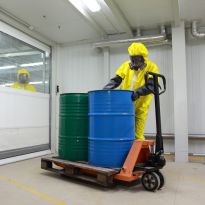Dry Cleaning
Dry Cleaning Safety

Hazards such as chemical, fire, and ergonomic-related are associated with dry cleaning processes. Exposure to hazardous chemicals commonly used in dry cleaning shops may occur through skin absorption, eye contact, or inhalation of the vapors. Perchloroethylene (PERC), a potential human carcinogen, is the most commonly used dry cleaning solvent. Symptoms associated with exposure include: depression of the central nervous system; damage to the liver and kidneys; impaired memory; confusion; dizziness; headache; drowsiness; and eye, nose, and throat irritation. Repeated dermal exposure may result in dermatitis.
A comparison of drycleaning and laundry industries shows the rate of injuries varied among industries in 2021. Employees in drycleaning and laundry services had an average injury rate of 3.2 per 100 full-time workers, employees in linen and uniform supply suffered an average injury rate of 4.3 per 100 full-time workers, and employees working for industrial launderers suffered an average injury rate of 3.3 per 100 full-time workers.
Courses For Your Industry
Click here to review our full list of courses.
Programs to Consider
-
General
Industry132-hour OSH Professional
Description
This program is the best value for ambitious students and employers who want to get the most out of their safety training experience. If you have high-career goals, are passionate about the field, and want to develop the skills needed to effectively manage safety in your workplace, this program provides the benefits you need to succeed. Maximize potential transfer credits, earn CEUs, or prepare for other professional credentials by completing this program now!
View Program DetailsFeatures
- 25 course certificates
- 7 program certificates
- training record card
- 2 transcripts
Required Courses
- International Students: 25 Courses
- Domestic (US) Students: 26 Courses
Fee
- FREE Access
- $ $ PDF & Original Certificates
- $ Original Certificates
- $ PDF Certificates
Shipping & Handling not included for original certificate prices.
-
General
Industry48-hour OSH Manager
Description
Companies hire occupational safety and health managers to design, develop, and deploy effective safety management systems within the organization. This program is designed for corporate and facility safety managers or directors who are responsible for establishing or managing their organizations safety and health program. Emphasis is placed on gaining the knowledge and skills needed to design, develop, and deploy a world-class safety management system.
View Program DetailsFeatures
- 9 course certificates
- 1 program certificate
- training record card
- 2 transcripts
Required Courses
- 700 Introduction to Safety Management
- 701 Effective Safety Committee Operations
- 702 Effective Accident Investigation
- 712 Safety Supervision and Leadership
- 716 Safety Management System Evaluation
- 717 Emergency Action Plans
- 718 Fire Prevention Plans
- 719 Fleet Safety Management
- 720 Preventing Workplace Violence
Fee
- FREE Access
- $ $ PDF & Original Certificates
- $ Original Certificates
- $ PDF Certificates
Shipping & Handling not included for original certificate prices.
-
General
Industry36-hour OSH Supervisor
Description
Supervisors are invaluable to a world-class safety culture. As an "agent of the employer," every supervisor has a legal obligation to understand his or her safety responsibilities in the workplace. This program helps supervisors develop the knowledge and skills to fulfill those responsibilities and be an effective leader.
View Program DetailsFeatures
- 7 course certificates
- 1 program certificate
- training record card
- 2 transcripts
Required Courses
Fee
- FREE Access
- $ $ PDF & Original Certificates
- $ Original Certificates
- $ PDF Certificates
Shipping & Handling not included for original certificate prices.
-
General
Industry36-hour OSH Train-the-Trainer
Description
This "Train-the-Trainer" program is designed to help students gain the knowledge and skills necessary to conduct occupational safety and health training for their employer. This program includes training program requirements, how to develop effective training, and best practices for presenting safety and health training. This program also covers important safety and health concepts every trainer needs to know.
The student's presentation skills should be evaluated locally by a training manager, competent person, or the student's employer.
View Program DetailsFeatures
- 7 course certificates
- 1 program certificate
- training record card
- 2 transcripts
Required Courses
Fee
- FREE Access
- $ $ PDF & Original Certificates
- $ Original Certificates
- $ PDF Certificates
Shipping & Handling not included for original certificate prices.
-
General
Industry36-hour Safety Committee Chair
Description
Many states require an employer to establish a safety committee/team to support a safe and healthy workplace. Unfortunately, too many safety committees/teams lack the leadership needed to be effective. This program is specifically designed to help develop the knowledge and skills of the safety committee/team leader (also called the chairperson). With a trained leader in place, committees will be able to have the momentum to be a powerful force for positive change within an organization.
View Program DetailsFeatures
- 7 course certificates
- 1 program certificate
- training record card
- 2 transcripts
Required Courses
Fee
- FREE Access
- $ $ PDF & Original Certificates
- $ Original Certificates
- $ PDF Certificates
Shipping & Handling not included for original certificate prices.
-
General
Industry32-hour Safety Committee Member
Description
Many states require fully trained safety committee/team members. Trained safety committee members are critical in helping the committee/team function successfully and achieve its goals. This program will help committee/team members understand their purpose and fulfill their roles as valuable internal consultants within the company.
View Program DetailsFeatures
- 6 course certificates
- 1 program certificate
- training record card
- 2 transcripts
Required Courses
Fee
- FREE Access
- $ $ PDF & Original Certificates
- $ Original Certificates
- $ PDF Certificates
Shipping & Handling not included for original certificate prices.
Click here to review our full list of programs.
Please note: Our training courses provide essential general knowledge awareness training about each topic, however an employer must provide training for the specific equipment, policies, and procedures in use at their work site(s).
Request a business account today!
We'll be able to set up an account within 1 to 2 business days at NO COST!























